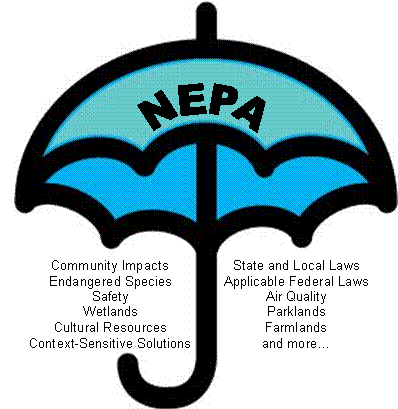The National Environmental Policy Act of 1969 (NEPA)
The National Environmental Policy Act of 1969 established a policy to promote the enhancement of the environment and the Council on Environmental Quality to assure all branches of the federal government consider impacts to the environment prior to undertaking federal actions.
NEPA was the federal government's first attempt at systematically addressing environmental issues and compelling agencies to consider environmental factors when making decisions. In fact, NEPA has been described as the most important and far-reaching conservation measure enacted by Congress.
What is the purpose of NEPA?
“To declare a national policy which will encourage productive and enjoyable harmony between humans and their environment; to promote efforts which will prevent or eliminate damage to the environment and stimulate the health and welfare of humans…”
NEPA is often called an umbrella policy, because multiple laws, executive orders and regulations are considered in the NEPA process. The following figure illustrates the factors involved in the NEPA process. Not only are natural environmental features studied; so are impacts to the economy and society.

NEPA is triggered by the use of federal funds regardless of the amount or phase in which it is used. The Maryland Department of Transportation State Highway Administration (MDOT SHA) ensures that its projects are federal aid eligible by following and complying with the NEPA process which is codified for the U.S. Department of Transportation (USDOT) and the Federal Highway Administration (FHWA) in 23CFR771.
The regulations define three “classes” of actions that determine the level of NEPA documentation required.
- Class I (Environmental Impact Statement or EIS): Actions that significantly impact the environment, for example a new controlled access freeway.
- Class II (Categorical Exclusion or CE): Actions that do not individually or cumulatively have a significant environmental effect, such as bridge rehabilitation, reconstruction or replacement.
- Class III (Environmental Assessment or /EA): Actions whose environmental impact is not clearly established. All actions that are not Class I or II are deemed Class III.
The Maryland Department of Transportation State Highway Administration (MDOT SHA) has a programmatic agreement (PA) with FHWA to streamline the NEPA process for minor projects. Under this PA, FHWA does not review minor activities, such as most system preservation improvements (i.e.: drainage improvements, resurfacing, guardrail placement, and traffic signal installation). These actions are reviewed by MDOT SHA staff and a Programmatic CE is submitted to FHWA as part of the construction authorization package.
What happens if there are no federal actions? MEPA!
Projects that are wholly funded by the State of Maryland are subject to the Maryland Environmental Policy Act (MEPA). MEPA requires state agencies to prepare an Environmental Assessment Form (EAF) or Environmental Effects report (EER) for each proposed state action. MDOT SHA uses an EAF if a project has no significant environmental impacts, while an EER is prepared if a state funded action has the potential for significant impacts.
Want more information? Check out the following links: